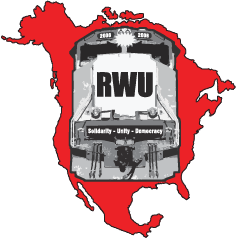RWU Campaign Against “Blame-the-Worker” Safety Programs
During the past several years we have seen an explosion of “Blame-the-Worker” safety programs on Class 1 railroads in the U.S. These programs have been fairly commonplace in other industries and many other labor unions have been struggling with them for years.
Technology, restructuring and work force reductions have made big changes, in the last decade, in how railroaders work. Many of these changes come with their own special set of adverse health and safety problems – such as fatigue, increased work load, repetitive strain injuries, stress, workplace violence, fatalities and other work-related injuries and illnesses.
Instead of seriously addressing these injury-causing hazards, most railroads have bought and implemented some sort of behavior-based safety program which attempts to put the blame on the actions of individual workers instead of the hazardous job conditions.
A variety of consultants and companies sell behavioral safety programs to employers throughout the United States and around the world. The leading companies include Dupont (the Dupont STOP program), Behavioral Science Technologies, Aubrey Daniels (SafeR+ program), E. Scott Geller's Safety Performance Solutions (Total Safety Culture program), Topf Organization (SAFOR program) and Liberty Mutual Insurance Company (Liberty's Managing Vital Performance - LMVP program). These programs identify "critical worker behaviors," train "observers" (workers and/or supervisors who observe worker behaviors) and use some form of "critical behavior check-lists" to document when a worker has engaged in a safe behavior or committed an unsafe act.
One of the keys to these programs is defining“culture” of observing employees’ unsafe acts and subsequently modifying their behavior. This is done instead of recognizing the underlying causes of those acts and modifying the worksite to make it safer. This practice makes it much easier to shift responsibility to the workers instead of management’s mandate to provide a safe workplace.
These programs also increase the amount of fear and intimidation on the job. Workers are hesitant to report an injury or illness for fear of being harassed as an unsafe worker or being disciplined for an unsafe act.
Additionally, union workers are recruited (and are put on the company payroll) to act as worksite observers or facilitators for these programs. This pits union worker against union worker and benefits the carriers by driving a wedge in union solidarity and undermining union efforts to effectively address worksite hazards.
Fortunately, we are not totally defenseless against these programs. On-the-job safety and health issues are mandatory subjects of bargaining under the law. This means that carriers are obligated to bargain with unions over changes in health and safety policies. It means that unions can propose a comprehensive health and safety program – focusing on hazard identification and modification or elimination - as an alternative.
The blame-the-worker approach of behavior-based safety programs is incompatible with, and designed to represent an alternative to, efforts - including those mandated by law - to identify and eliminate or reduce the hazards responsible for the epidemic of worker injuries, illness and death. In a time of major work restructuring and speed up, critics say the focus on individuals at the expense of work environments makes behavior-based safety programs themselves a work hazard that must be eliminated.
If your local is faced with problems caused by a behavior-based safety program, RWU can help with tools to combat the BBS program and create a union-based alternative.
Please feel free to use any of the materials below and contact us for more help:
